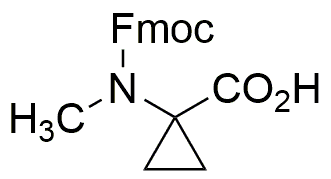Fmoc-1-methylaminocyclopropane-1-carboxylic acid is widely utilized in research focused on:
- Peptide Synthesis: This compound serves as a protective group in the synthesis of peptides, allowing for the selective modification of amino acids without affecting the overall structure. This is crucial in developing complex peptides for pharmaceuticals.
- Drug Development: Its unique structure aids in the design of novel drugs, particularly in the field of oncology, where targeted therapies are essential. Researchers can modify the compound to enhance bioavailability and efficacy.
- Bioconjugation: The compound can be used in bioconjugation processes, linking biomolecules to create targeted delivery systems. This is particularly beneficial in developing therapies that require precise targeting of cancer cells.
- Material Science: In polymer chemistry, it can be incorporated into materials to enhance properties such as flexibility and strength, making it valuable in the production of advanced materials for various applications.
- Research Tools: It is utilized as a reagent in various chemical reactions, providing researchers with a versatile tool for studying reaction mechanisms and developing new synthetic pathways.
General Information
Properties
Safety and Regulations
Applications
Fmoc-1-methylaminocyclopropane-1-carboxylic acid is widely utilized in research focused on:
- Peptide Synthesis: This compound serves as a protective group in the synthesis of peptides, allowing for the selective modification of amino acids without affecting the overall structure. This is crucial in developing complex peptides for pharmaceuticals.
- Drug Development: Its unique structure aids in the design of novel drugs, particularly in the field of oncology, where targeted therapies are essential. Researchers can modify the compound to enhance bioavailability and efficacy.
- Bioconjugation: The compound can be used in bioconjugation processes, linking biomolecules to create targeted delivery systems. This is particularly beneficial in developing therapies that require precise targeting of cancer cells.
- Material Science: In polymer chemistry, it can be incorporated into materials to enhance properties such as flexibility and strength, making it valuable in the production of advanced materials for various applications.
- Research Tools: It is utilized as a reagent in various chemical reactions, providing researchers with a versatile tool for studying reaction mechanisms and developing new synthetic pathways.
Documents
Safety Data Sheets (SDS)
The SDS provides comprehensive safety information on handling, storage, and disposal of the product.
Product Specification (PS)
The PS provides a comprehensive breakdown of the product’s properties, including chemical composition, physical state, purity, and storage requirements. It also details acceptable quality ranges and the product's intended applications.
Certificates of Analysis (COA)
Search for Certificates of Analysis (COA) by entering the products Lot Number. Lot and Batch Numbers can be found on a product’s label following the words ‘Lot’ or ‘Batch’.
Numéro de catalogue
Numéro de lot/série
Certificates Of Origin (COO)
This COO confirms the country where the product was manufactured, and also details the materials and components used in it and whether it is derived from natural, synthetic, or other specific sources. This certificate may be required for customs, trade, and regulatory compliance.
Numéro de catalogue
Numéro de lot/série
Safety Data Sheets (SDS)
The SDS provides comprehensive safety information on handling, storage, and disposal of the product.
DownloadProduct Specification (PS)
The PS provides a comprehensive breakdown of the product’s properties, including chemical composition, physical state, purity, and storage requirements. It also details acceptable quality ranges and the product's intended applications.
DownloadCertificates of Analysis (COA)
Search for Certificates of Analysis (COA) by entering the products Lot Number. Lot and Batch Numbers can be found on a product’s label following the words ‘Lot’ or ‘Batch’.
Numéro de catalogue
Numéro de lot/série
Certificates Of Origin (COO)
This COO confirms the country where the product was manufactured, and also details the materials and components used in it and whether it is derived from natural, synthetic, or other specific sources. This certificate may be required for customs, trade, and regulatory compliance.


